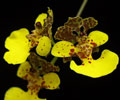|
|
|
|
|
| |
Flasks of
Oncidium cebolleta |
|
| |
|
|
| |
| Number: |
TN1491 |
| Name: |
Oncidium cebolleta
|
| Type: |
unknown (What's that?) |
|
Seed Donor: |
Bill Schneider
|
|
Click to Enlarge

Offspring 'MC3085' Flowers |
| Offspring photos are siblings of the plants you would receive. |
|
|
|
| |
Comments: Parent plant: A "rat-tail oncidium" with an inconspicuous pseudobulb and a long, succulent tapered leaf resembling a rat tail in shape.
For additional origin/habitat information supplied courtesy of
Charles and Margaret Baker, see further below, near the bottom of this page.
|
Temperatures we attempt to use in the lab & greenhouse:
| For Species: |
|
Spring, Summer, Autumn: days average 86°F, nights 69°F; best fit is Warm-Intermediate 87-64°F
(Source:
Baker's Web OSC) |
| For Species: |
|
Winter: days average 89°F, nights 64°F; best fit is Warm-Intermediate 87-64°F
(Source:
Baker's Web OSC) |
|
About the name...
| Etymology of |
cebolleta |
|
From Spanish "cebolleta" green onion.
(Source:
Troy Meyers) |
| Etymology of |
Oncidium |
|
From Greek "onkos" tumor, swelling. Refers to the warty callus of the labellum.
(Source:
Pridgeon 1992) |
| Pronunciation of |
cebolleta |
|
se-bol-AY-ta
(Source:
Hawkes 1978) |
| Pronunciation of |
Oncidium |
|
on-SID-ee-um
(Source:
Pridgeon 1992) |
|
If you would like to direct someone to this web page, please copy and paste this URL into your email:
http://troymeyers.com/d?011491
| Flask Information |
| Availability: |
We had yield problems with this item, so we didn't continue flasking it. |
| You should: |
Consider placing a "Notify Retries" Request, and if an identical pollination (the same parents) is done again, we'll let you know. |
| Plantlet Sizes: |
From many flasks 12 - 55 mm plants (based on flask surveys done 07/05/2002 )
From one most recently surveyed flask 12 - 55 mm (07/05/2002)
|
|
You might also want to:
|
View the seed assay for this item.
View items of the same species.
View items of the same genus.
|
|
|
| |
The origin/habitat information below is supplied courtesy of Charles and Margaret Baker
The following information is based on the name of the plant provided by the donor, and assumes that the name is correct. If the plant has been misidentified, then the following information may not be correct.
This text is copyrighted by the Bakers and may not be reproduced without permission.
ORIGIN/HABITAT: Originally found in Colombia near Cartagena, Oncidium
cebolleta, the most widely distributed of all Oncidium species, is now
known to occur from Mexico through the West Indies and Central and South
America to as far south as Brazil, Paraguay, and Argentina. These plants
generally grow at below 1950 ft. (600 m) in semiarid regions or in areas
with a pronounced dry season. Plants have, however, been reported from
moist forest areas and from elevations as high as 5900 ft. (1800 m). In
Mexico, these plants grow as epiphytes in both semiarid scrub and humid
forests from sea level to 5900 ft. (1800 m), with reports of plants from
as high as 7850 ft. (2400 m), and have been reported from the states of
Chiapas, Guerrero, Jalisco, México, Michoacán, Morelos, Nayarit, Oaxaca,
Sinaloa, Sonora, Veracruz, and Yucatán. Dunsterville and Garay (1961)
reported this species as, "Common in most relatively hot parts of
Venezuela with fairly long dry season, e.g. surroundings of Lake
Valencia." In Surinam, plants are known only from the coastal plain; but
in Brazil they are found almost throughout the tropical regions, with
occurrences reported in the Amazon Basin as well as the northeast,
southeast, and the central western regions including the states of Acre,
Amazonas, Pará, Piaui, Pernambuco, Bahia, Espírito Santo, Goiás,
Tocantins, Mato Grosso, Minas Gerais, Roraima, and São Paulo. In Peru,
plants discussed as Oncidium sprucei Lindley by Dodson and Bennett (1989)
were found in the Department of San Martin. They were growing as epiphytes
in tropical wet forest in bright light on old citrus trees near Moyobamba
and about 3 mi. (5 km) south of Tocache at 1300 ft. (400 m).
More about this information and the Bakers...
|
|
|
| |
|
|
|